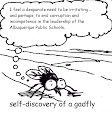The first has to do with legislative efforts to erase criminal records, link. All I would add is; the editorial could just as well have been written about erasing the discipline records of students. Including the fact that the legislature wants to erase student discipline records by law, link. The records of the most chronically disruptive students are erased so quickly, they might just as well be written in disappearing ink.
Apologists for the ceaseless second chance; the consequence for most APS students who ignore rules, will defend the relentless postponement of meaningful consequences despite the manifest failure of the approach. The actual evidence, the real data on the effectiveness of the ceaseless second chance is so damning that it doesn't exist. The leadership of the APS does not gather the data, they do not record the data. That, or they do gather data, and they're hiding it, link.
The relevant data is either not compiled or hidden because it is evidence of administrative incompetence, plain and simple. Is that not evidence tampering? Is that not malfeasance?
The enforcement of school and district discipline policy is first and foremost, an administrative responsibility. If schools are *out of control, the administration is where the buck stops (try as they may to foist the onus on to teachers who have no authority to impose meaningful consequences for deliberate misconduct).
*A school is out of control, if the standards set by the adults are ignored by the students. The person whose will is being done, is in charge.The second editorial, link, had to do with a school spirit raising effort at Del Norte High School.
It is against APS School Board Policy for students to sag.
This is not about sagging. It is about the permission of
prohibited behavior.
Go to any APS school. Are there kids sagging?
If there are, those students are in charge at that school.
I will preface my observation of that effort by pointing out that I have a quarter of a century of teaching experience in the APS including a few years at Del Norte. The observations of current APS teachers would be more relevant. Between them, they have nearly 100,000 years of teaching experience in the APS, 4,000 times more than I.
I have seen a lot of clever attempts to change the reality the teaching and learning process. Despite relatively small success stories, none of them change the fundamental truth that, except for very momentarily, there is no such thing as a reluctant and disengaged learner.
You can lead a horse to water, but you can't make it drink.
You can make students sit in desks,
you can't make them want to there.
If students want to learn, we can help them.
If they don't want to learn, all we can do is wait until they do.
And in the meanwhile, try to expose them to as many different things as we can until we finally catch their interest.
Students at Del Norte will sign a pledge the editors argue;
puts students' academic future firmly in their hands as they agree to stay on top of their transcripts, find a mentor, ask teachers or staff for help if needed, choose friends wisely and help inspire classmates to succeed.It is not the pledge that will enable them, it is their agreement.
As the editors wrote; it is their buy in.
Any student who doesn't buy in, is no closer to a diploma than they would be otherwise.
Students who don't want to become educated simply have not found something they want to be educated in. The more choices we can offer, the more likely it is they will find something they want to learn. Then we teach them how to learn; our real goal.
I wish Del Norte students the best of luck. I hope many more of them do graduate with meaningful diplomas.
The obstacle they must surmount; cemetery seating; the relentless belief that thirty kids with nothing in common but the year of their birth can learn in unison. Even if a thought choir could be formed, why would you want to? How could that possibly improve on every student learning at their own speed?
Why isn't the goal, and therefore the immediate primary objective of education creating independent lifelong learners at the very earliest opportunity?

No comments:
Post a Comment